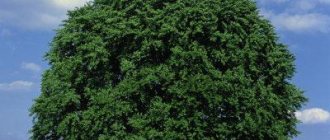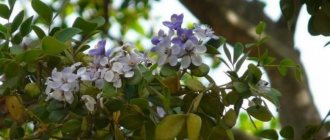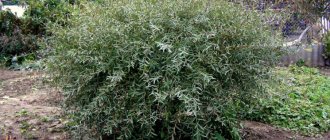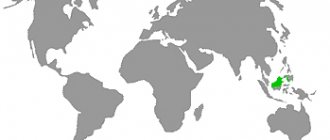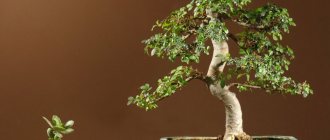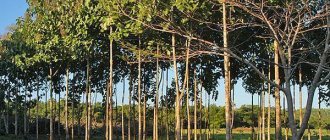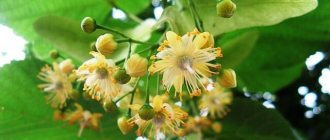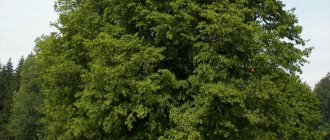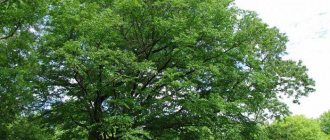On the streets and squares of southern cities you can see the plane tree - a tall tree with a spreading crown and a powerful trunk. This tree is considered one of the oldest, because the age of the oldest representative exceeds 2300 years. Residents of Ancient Greece and Persia considered plane tree the most beautiful tree of the East. Thanks to its wide distribution area, different ecological types of plane trees have formed. Today, its varieties can be found in regions with fairly harsh climatic conditions.
Description of the genus
Sycamore has a very high life expectancy. It lasts 800-1000 years, and some species live up to 2000 years and above. In addition, it is distinguished by its large size; it is not for nothing that “sycamore” is translated from Greek as “wide”. The tree grows throughout its life. This is due to the active production of cambium. This is an educational tissue in the stems and root system, providing thickening of the woody layer. The formation of the organic polymer lignin in wood helps to increase its strength and quality.
The height of the trunk can reach 50 m, and the diameter of the trunk is 8 m. It is protected by a dense layer of greenish or brown bark. The tree sheds its mature bark in thin sheets, revealing a young yellow-green surface. This property helps the plant not to accumulate toxins and withstand the unhealthy atmosphere of the city, oversaturated with exhaust gases.
The leaves of the plane tree are large, can reach 30 cm in length. They resemble maple leaves in shape - palmately lobed, dense, attached to long petioles.
In spring, the bright bush looks very impressive. Its branches are covered with clusters of small female and male flowers on long peduncles. Flowering soon gives way to fruiting. Numerous multinut fruits are small cone-shaped balls covered with stiff bristles. They consist of a mass of small fruit heads with seeds, united by a hard pericarp. The fruits do not leave the tree even after the leaves fly off. And only next spring they break up into individual seeds and are carried by the wind.
Varieties of plane trees
The plane tree is widespread in the countries of America, East Asia, and the Mediterranean. Wild specimens grow along the banks of rivers and reservoirs, forming small groves. Currently, there are about 10 species of plane tree. Wild species and hybrid varieties are known.
The main difference between the types of sycamore tree is the appearance of the leaves and fruits. There are several types of this plant:
Common plane tree . The tree reaches a height of 35−40 m, forming a round crown. The plant grows very quickly. Widespread in North America since the late 18th century.- American or western sycamore. This is the largest variety. The height of individual specimens can reach a height of up to 50 m. The leaves are 3-5-lobed. Inflorescences are single-headed. This species is most common in Western Europe, Belarus, Stavropol, Dagestan, and Adygea.
- Oriental plane tree , or plane tree. The leaves have narrow lobes. The edges of the leaf blade are slightly jagged. Flowers are collected in complex multi-headed inflorescences. Chinara grows in Crimea, Ukraine, Central Asia, and Moldova.
- London sycamore , or maple leaf. This is a hybrid variety of the western and eastern species, which is distinguished by long five-lobed leaves, reaching a length of 20 cm and having a heart-shaped base. This species is resistant to low temperatures and tolerates winter frosts. It is grown in the Caucasus, Armenia, and Crimea.
Types of plane tree
The genus of trees Platanus (Platanus) includes from 10 to 11 species, slightly different in appearance and climatic preferences. The most common are:
- Western sycamore (syquimora) is native to North America and is the most frost-resistant. It tolerates harsh winters when temperatures drop to minus 35 °C. The trunk is up to 40 meters high and supports a rich, spreading crown. The span of the branches reaches 25 meters. This type is also called white sycamore, after the color of the creamy white wood. This variety does not tolerate prolonged drought.
- Chinara or eastern plane tree can be seen on the streets of the cities of Crimea, the Caucasus and Central Asia. The most picturesque view, reaches a height of 30 meters. It has a cylindrical trunk and a powerful dome-shaped crown. The leaf is also large - up to 30 cm, five-lobed. Every summer, the plane tree throws out many clusters, each of which contains 5-7 prickly reddish “plane trees”. The tree easily tolerates frost down to -15 °C. The foliage does not fall off for a long time, remaining on the tree until the beginning of the next growing season.
- The Kerr sycamore, originally from Indochina, differs from other species, as evidenced by its leaves - oblong, whole, leathery. But the anatomical structure of the vegetative organs of this Far Eastern plane tree resembles the ancient species that lived in the Tertiary period, of which it is a descendant.
- The maple-leaved or common plane tree is an artificial, hybrid species obtained by crossing the eastern and western ecotypes. These are tall (over 40 meters) trees with a powerful crown, in the shade of which up to 300 people can fit. They are frost-resistant and adapted to the harsh climate of central Russia. In accordance with the name, the leaves are very similar to maple (three to five lobed, with pointed tips).
- Mexican is a southern sycamore whose habitat is primarily limited to the borders of Mexico. Planted to decorate the streets and courtyards of this country. In the wild it grows in river valleys. It reaches a height of 45 meters. It has bristly fruits up to 2 cm in diameter, consisting of 3-4 fruit heads collected together.
- Wright's sycamore - grows in cities in Mexico and the USA. The tree reaches 25 m in height. The straight, dividing trunk holds a lush, dome-shaped crown composed of thin, heavily dissected leaves. The fruits are several fruit heads collected on a long stalk.
- Sycamore sycamore is a native of North America. Used to build street landscapes. Reaches 36 m in height, has a powerful rounded crown and a bifurcating trunk. The leaves are large, dissected, bright green. The bristly fruits contain from 2 to 7 seeds protected by the pericarp
A tree from the ancient genus sycamore is an unpretentious plant, resistant to diseases, pest attacks and a polluted urban atmosphere. Grows well in alkaline soils, loves humid and warm climates, and does not tolerate prolonged drought. Dense foliage releases a large amount of oxygen into the atmosphere, thereby helping to improve the ecology of the city.
Eastern plane tree or plane tree
The eastern plane tree, Platanus orientalis, which is called plane tree in Turkish and Persian, grows in the Central Asian region. The plane tree (photo above) is most often found in the Caucasus. It is quite tall (up to 30 meters), the trunk diameter can reach 15 meters. The crown is wide and low. This plant is fruit bearing. The plane tree blooms in early spring, but does not please others for long. The ovaries that appear are multi-nuts, which the residents call “plane trees”. They are edible. Nuts remaining on the tree in February-March are carried by the wind over long distances. The eastern sycamore is considered the most frost-resistant among all plant varieties.
Spreading
Traces of the growth of ancient plane trees were discovered in Europe, the Far East, Siberia and Kazakhstan. The range of modern culture is much wider than is determined by the large number of species:
- Oriental plane tree grows on the Balkan Peninsula, in the forests of Central and Asia Minor and in the Mediterranean, the Black Sea coast;
- western plane tree territory - North America;
- Kerr's plane tree is common in Indochina, the lands of Vietnam and Laos;
- The homeland of the Mexican sycamore is Northeastern Mexico;
- Sycamore sycamore was born in Central and North America;
- Wright's sycamore is a resident of the USA and Mexico.
Long-lived tree
Sycamore is common in North America, East Asia and Europe. It is considered to be one of the longest-living plants. It is known that more than one thousand oldest trees grow on the territory of Azerbaijan. You can see what the oldest trees look like in Turkey, where a specimen grows that is more than two thousand years old.
This tree has long been revered as sacred. In Ancient Egypt, it served as a symbol of the sky and was dedicated to the goddess Nut.
Songs and poems were written about this tree; its image was preserved in mosaics on the walls of ancient mosques. The plane tree was considered sacred because no one knew how long the plane tree lived.
Planting and care
In order to grow a luxurious plane tree, it is necessary to provide it with an abundance of light, moderate humidity and sufficient heat. It makes sense to start breeding it only where the climate is relatively mild. For it you need to choose a spacious, sunny area on a plain or hill. The root occupies a significant volume, so when planting two plants, a significant distance should be maintained between them. The tree should not be placed near buildings or where underground utilities pass.
Priming
Sycamore grows well in any soil, although for some species a lime composition is preferable. The main condition is to maintain the required level of fertility, sufficient humidity and constant access of oxygen to the roots.
Landing
Planting an ornamental plane tree begins with choosing a seedling. It is recommended to give preference to the species that is more common in a given region. Such a tree will take root faster and grow better.
When purchasing a seedling, you should pay attention to the presence of a main root coming from the root collar. If it is absent, then the plant is not a seedling, but a rooted cutting. It will have worse survival rate and low cold resistance.
Before planting, you should pick off the leaves of the seedling. Otherwise, he will spend energy on building up deciduous mass, and not on developing the root system. The planting date should not be late spring or early autumn.
Watering
A young tree will actively grow only if it is regularly watered. Its future power and beauty depends on this. With a lack of moisture, growth slows down, and the leaves curl and take on a rusty tint.
Top dressing
A growing plane tree needs feeding. When choosing fertilizers, preference is given to complex mineral products containing the necessary set of minerals and trace elements (such as Kemira). Your own fallen leaves can be used as fertilizing. Left under a tree, it will gradually rot, turn into fertilizer and give life to beneficial microorganisms. In addition, it will act as mulch, protecting the roots during the winter cold.
Trimming
Decorative pruning of the plane tree can be eliminated. It is done if the gardener wants to reduce the weight of the crown, wants to make it round and symmetrical. It is recommended to prune in early spring, before tree sap becomes active. At the same time, dried and broken branches in winter are removed.
Preparing for winter
If the winter temperature in the region drops below 25°C, then the plane tree must be prepared for the cold. Preparation consists of protecting the roots with a thick layer of mulch made from sawdust, spruce branches, and fallen leaves.
Care Tips
The first thing to remember when planting a tree is a respectful distance from buildings. A powerful root system can eventually destroy the foundation and communications. The best place would be near a pond. In nature, these trees grow in gorges and near ponds. From this it follows that the tree needs watering in dry times. If there is a lack of water, tree growth slows down and the color of the leaves becomes faded.
Feeding for the giant plane tree (the photos allow you to understand how huge they are) is important only during the growth period of the young tree. The main thing is not to overdo it. The best fertilizers for plane trees are substrates rich in mineral and organic elements.
Pruning is necessary for a tree both to remove damaged shoots and to obtain a certain type of crown, for example, spherical. The hardiest of all sycamore varieties is the maple-leaved one.
Reproduction
To plant on a plot, seedlings are purchased or grown from seeds (by cuttings). Both methods are effective. In central Russia, preference is often given to the most frost-resistant wedge-leaved species. In the south, picturesque plane trees are planted.
Propagation by seeds
Propagation by seeds is a labor-intensive process. Seed material is pre-prepared. To do this, the ripe fruits are separated into individual seeds and poured into a fabric bag. Next, vernalization (adaptation to low temperatures) is carried out: a bag of seeds is buried in the ground or sand and stored at a temperature from 0 to +10 ° C. This contributes to their disinfection and hardening.
In spring, the seeds are soaked in a weak solution of potassium permanganate for half an hour, then placed in cool water for germination. After the first shoots appear, they are planted in containers with a peat-sand mixture, deepening the seeds by 20 mm. By stretching polyethylene on top, they create a warm and humid atmosphere for the seedlings - ideal conditions for active growth. After emergence, the film is removed and the sprouts are left alone, providing heat and light conditions. After strengthening the root system, the seedlings are transferred to open ground.
Cuttings
In late autumn, a cutting about 40 cm long is cut from a healthy side branch. Cut side down, it is placed in water, after adding a root formation stimulator. In the spring, after the beginnings of roots and buds appear, the cuttings can be planted in the ground. The future tree is planted in moist soil, buried two-thirds deep. They take care of it carefully, waiting for it to take root and get stronger.
Root suckers and layering
Babies often develop at the roots of an adult tree. Select the largest ones and separate them, capturing part of the root. In spring or autumn, the resulting shoots are planted in the ground and watered abundantly. The survival rate is improved by mulching the tree trunk circle. Mulch will retain the warmth the roots need in winter, and in summer it will not allow moisture to evaporate.
It is possible to propagate the plant by layering if the plane tree is still young. A small cut is made on the lower branch, it is bent and fixed near the ground. Apply drops to the cut site and water generously. If everything is done correctly, young roots will soon appear. Then the shoot is separated from the mother tree and planted in the chosen location.
Sycamore is characterized by very fast growth and, with proper care, will reach 1-1.5 meters in 2 years.
Growing in your garden
This mighty tree can be planted on the site using seeds, which are best pre-soaked. It needs to be buried in the ground to a depth of 50 cm. In this case, the sprout will sprout very soon. Growing it does not require any special skills. But you still need to know a few conditions, the observance of which will help you grow healthy plane trees. The tree requires sufficient watering and light. At the same time, he is not threatened by the cold, since he endures them steadfastly. At a young age, if necessary, you can organize mineral feeding. But before you carry out this procedure, it is important to determine exactly what your plant is missing. If this is difficult to do, you can use a complex universal fertilizer, but you should take into account the measure. It can be noted that this tree is so unpretentious and fast-growing that it is often chosen for urban landscaping.
Diseases and pests
Of the tree infections, fungal infections are the most dangerous for plane trees. When infected, the bark is the first to react with the appearance of a dark coating. The disease then causes the branches to dry out, and subsequently the death of the entire tree. Tree parasites (sycamore laceweed) are often carriers of fungal diseases. Therefore, insecticides (Aktaru, Aktellik, Karbofos) should be used to prevent fungal infections.
Fungal infection of foliage is called anthracnose. The disease is manifested by a change in color and the appearance of cracks on the leaf plates. An effective measure to combat anthracnose is the use of fungicides (Fundazol, Bordeaux mixture).
In construction
It is worth noting that specialists in the construction industry especially value plane trees. Wood has unique properties, and above all this concerns its color. Veneer is often made from it, which comes in a wide range, from rich red to pink-gray. Sometimes you can find yellow wood. Such a varied color spectrum gives the product originality. The rock itself is quite hard and dense. Although it has two drawbacks - it is prone to rotting and warping. But this can be avoided with sufficient processing.
Meaning and Application
Sycamore is a truly universal tree, as its wood, bark, leaves, and fruits are widely used.
- Plane wood is highly valued for its noble texture and high quality. It is durable, but easy to process, and is a valuable raw material for furniture and wooden crafts. The surface has an expensive golden-reddish hue. It is often compared to snake skin.
- The medicinal properties of sycamore are used in folk medicine. The foliage contains special substances - flavonoids, myricetin, caffeic acid, so extract from the leaves is an excellent remedy that has a beneficial effect on blood vessels, skin, and the nervous system. The bark is rich in betulin and its compounds, has excellent astringent, wound-healing and disinfectant properties.
- Many types of plane trees are valuable ornamental plants grown for landscaping city gardens and public gardens. They can significantly improve the microclimate, clean the air from harmful impurities and saturate it with oxygen.
Interesting facts about the sycamore tree
Sycamore is not just an ornamental tree, but also a plant that has truly many medicinal properties, which were noticed by ancient healers and were successfully used in the treatment of various ailments.
- Infusions from the leaves have a beneficial effect on the skin, blood vessels and nervous system.
- Betulin, a substance with astringent, wound-healing, and antitumor properties, was found in the bark.
- Plane tree leaves are used in love magic to preserve affection between spouses and gain newness of feelings.
Unripe fruits of the tree, hung in the hallway of the house, do not allow negative energy into the home and protect its inhabitants from evil and hatred.
The Spaniards have a beautiful tradition - people in love, when parting for a while, tear a leaf of a plant in half and carefully keep their half as a guarantee of a speedy meeting.
Use in landscape design
Plane trees are famous for their luxurious crown, so they are often planted in the garden to create a cozy shady corner. Usually, a recreation area is organized under the trees so that on a hot day there is an opportunity to relax in dense shade.
Decorative plane trees are also used in landscape design to decorate the streets of southern cities. They look picturesque in a composition with bright shrubs. The crop is also grown as a tapeworm (a free-standing tree).
Health in your garden
If you decide to plant this giant on your site, it can not only serve as decoration. Chinar is a tree with medicinal properties. Leaves, bark and roots are suitable for these purposes. Although beneficial substances are also found in fruits.
The bark of the young plant is used as an anti-cancer drug. 15 g of crushed raw materials should be poured with an incomplete glass of brew. Set aside for two hours. Take the strained medicine one third of a glass a day three times.
You can prepare a hemostatic agent from the roots. To do this, you will need to grind them and pour 20 grams of boiling water over half a glass. Place in a water bath and wait 20 minutes. Strain and replenish the original volume with boiled water. Drink a tablespoon four times a day. This decoction is also taken as an antidote in case of snake bite. To do this, you need to drink half a glass of the “potion” two or three times a day.
For dysentery, toothache, flu, and diarrhea, the bark is brewed. 20 g of raw materials, a spoonful of vinegar and water (300 ml) are placed in the container. You need to boil for five minutes. Leave for an hour, then strain. Drink half a glass three times a day before meals.
You can brew crushed leaves to make rinses and lotions for conjunctivitis and blepharitis. To do this, three tablespoons of dried raw materials are infused for two hours in two glasses of boiling water. The strained solution is applied externally.
Main varieties
Plane trees have several interesting varieties, among which deserve special attention:
- Eastern plane tree. This plant is the most common and especially popular. In addition to Central Asia, this crop also grows in southern Ukraine, Moldova and Crimea. The culture is growing rapidly. Young plant trunks can gain height up to one meter per year. The seeds continue to remain viable throughout the year. The plane tree quickly adapts to growing conditions, including the urban landscape.
- Western Sycamore (shameless). Western culture is notable for its unpretentiousness to low temperatures and place of growth. The tree is quite large and reacts negatively to lack of watering. The height in some cases reaches only fifty centimeters. In North America, only sequoia grows taller than such a plant. The leaves are equal in length and width, the fruits grow individually and in some cases are collected in groups of two or three nuts.
- Hybrid variety. In Europe, a hybrid of eastern and western sycamore, cuneifolia, has become especially popular. The tree reaches a height of up to forty meters; it was widely cultivated in the Old World in the 17th century. The plant is superior to its parents in resistance to low temperatures and can grow freely even in the British Isles and Scotland. The leaves reach sixteen centimeters in length and have five lobes.
In the winter season, many varieties of sycamore, even after all the foliage has fallen and pruned, continue to remain beautiful and graceful. In winter, the thick trunks of the plant look especially beautiful, through the bark of which you can see the mounds of knots, and the peeling bark continues to expose the variegated inner layers of the tree.
Unlike plane trees, lichens are primitive organisms that include a combination of algae and fungi. The plant grows very slowly and often dies in areas with severe air pollution with carbon monoxide, sulfur, hydrocarbons or nitrogen compounds.
An urban eastern maple with lichens growing is a rather rare occurrence, but the absence of lichens on a tree may indicate severe air pollution with hazardous substances that are bad for human health.

